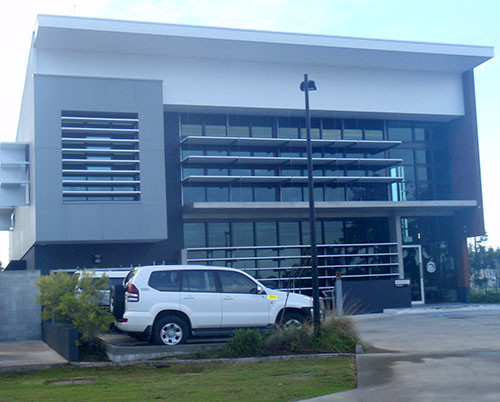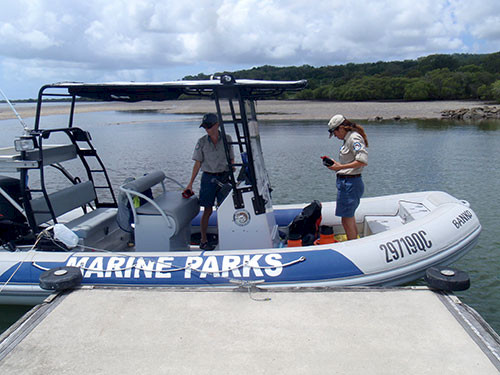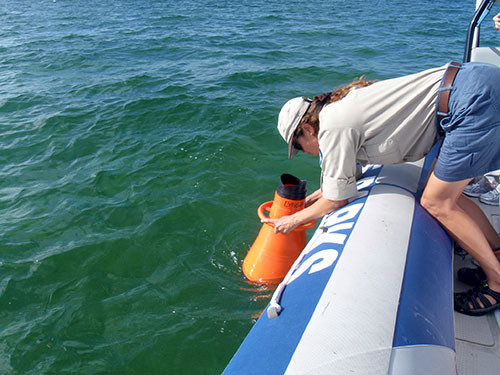Moreton Bay seagrasses after the flood
Bill Dennison ·Queensland Parks and Wildlife rangers conduct regular surveys of seagrasses and Lyngbya majuscula (a cyanobacterium that has been blooming in Moreton Bay for over a decade). I was able to tag along for a look at the Bay and the benthic communities of the Eastern Banks. The Eastern Banks of Moreton Bay are very special--they support large populations of green sea turtles and dugong, a relative of the manatee. The Eastern Banks are shallow, coming exposed or nearly exposed at low tide, and are less than a few meters deep even at high tide (tide range is about 1.5 m). The banks are formed from sand that enters the Bay through South Passage, one of the openings between the Pacific Ocean and Moreton Bay. The flood tide delta is comprised of several separate banks, and the two largest banks are called Moreton Banks and Amity Banks.

We started out from the new facilities for Moreton Bay Marine Park located at Manly Harbour. We launched a rigid inflatable and crossed Moreton Bay and navigated the Rous Channel that separated Moreton and Amity Banks. The rangers use a glass bottomed viewing box called a bathyscope to view the bottom at regular intervals on transects, allowing the boat to drift over shallow water. We could clearly see the seagrass and in some locations, Lyngbya. The limitation of viewing from the surface is the difficulty in some of the seagrass species identification, particularly when distinguishing similar looking species (e.g., the small form of Zostera capricorni vs Halodule uninervis) or locations where Lyngbya was so thick that the seagrass was completely covered. A partial solution was to use a small grappling hook, but my recommendation is to have a snorkeler roll off the side of the boat, quickly grab a sample and flop back into the boat. Leaving the motor in idle, and drifting while the snorkeler is in the water would be safer (and more efficient) than anchoring, as the current may sweep the snorkeler away from a stationary boat, and it would take some time to retrieve the anchor to chase after the snorkeler. The unanchored boat would tend to drift with the snorkeler and would be ready to kick into gear if retrieval was necessary.



What we found was reassuring. We found healthy seagrass, without sediments or excessive epiphytes on their leaves, two potential scenarios from the recent flood plume that covered Moreton Bay. There was even significant Lyngbya, which would likely have been shaded out if the water was too turbid. I heard that was the case in Deception Bay, a part of northern Moreton Bay that was directly in the flood plume. We saw green sea turtles and dolphins, but no dugongs. However, we could see evidence of fairly recent dugong feeding, based on feeding trails through the seagrass. It appears that the Eastern Banks seagrasses were largely spared from the flood plumes, and the turtles and dugongs will fair well.
There were some ideas about attempting to clean the seagrasses, but this survey shows that to be unnecessary in the Eastern Banks. Even in locations where the seagrasses were more directly exposed to flood waters, cleaning would not help, and depending on the method used, could actually do more harm. Since rapidly growing seagrasses (e.g., during summer months) produce new leaves within ten days or so, leaves that were coated with sediments or epiphytes would be essentially replaced anyway; certainly faster than a field crew could get around the Bay.
As we were driving the boat around Moreton Bay, I began to reflect that it had been twenty five years since my first trip to see Moreton Bay seagrasses. As part of my Coastal Marine Scholar postdoctoral at Stony Brook, New York, I had tagged along to Australia with Professor Doug Capone and his wife Linda Duguay to work at the Australian Institute of Marine Science (AIMS) near Townsville, in northern Queensland. While snorkeling off Magnetic Island to watch coral spawning, I met a researcher from Brisbane who said that her husband, Ian Poiner was back in the hotel room looking after the kids, but was a seagrass person that I should talk to. I did catch up with Ian and he invited me to Brisbane and organized a trip out to see Moreton Bay seagrasses. Ian went on to become a key colleague when I arrived in Brisbane a decade later when he headed the CSIRO lab in Cleveland, and then went on to his current position as Director of AIMS.
There were several marked differences from my first trip a quarter century ago. 1) The field crew twenty years ago was all male, and apart from myself, the field crew were all women on this recent trip, reflecting a trend in environmental sciences as a female dominated field. 2) The boat was better equipped, with GPS navigation, mobile phones, quiet four stroke motor and overhead canopy, making for a pleasant trip. 3) The much better understanding of Moreton Bay provided more context to everything we saw; satellite imagery, an ongoing monitoring program that we were contributing to, models, books and papers all provided context. I was gratified to see that the rangers were using a seagrass identification guide that my Marine Botany group at University of Queensland had produced years ago.
About the author
Bill Dennison

Dr. Bill Dennison is a Professor of Marine Science and Vice President for Science Application at the University of Maryland Center for Environmental Science.


